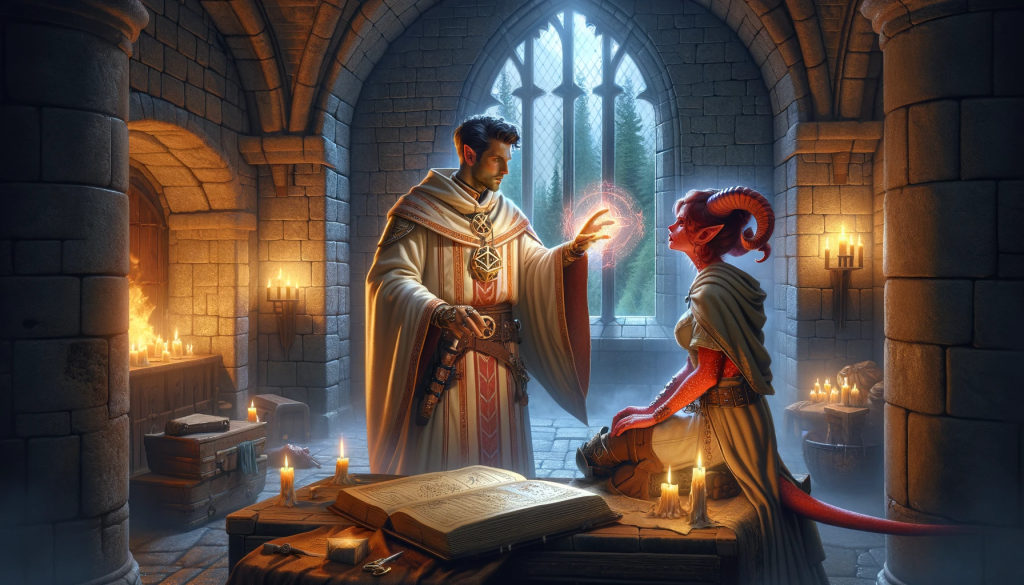How to Calculate Hit Points 5e D&D
Hit points (HP) are a central mechanic in Dungeons and Dragons fifth edition (D&D 5e). They determine your character’s mental and physical durability. That’s why it’s crucial to understand how hit points work.
In this article, we’ll cover the basics of HP in D&D, including what they are, how you can calculate them, and how they work during combat. After reading this, you’ll have a solid understanding of HP and how to use it in your next D&D campaign.
What Are Hit Points?
Hit points represent how well you can take hits. The HP number measures your character’s overall well-being. Constitution plays a crucial role in determining your HP. As you level up, you gain more HP based on your class, making you even tougher to defeat.
Role of HP
For living creatures, HP measures how close to falling unconscious. A character is bloodied and visibly injured when their HP falls below half.
For an inanimate object, breaking it requires dealing a specific amount of damage. By managing your hit points, you can increase your chances of survival.
What Determines Player Hit Points?
Several factors determine your HP, including your character’s class, level, and some feats. You can also gain bonus hit points temporarily to increase your HP. Let’s look at these factors to understand better how they affect your HP.
Classes and Hit Dice
Your character’s class is the biggest factor in determining your HP. Each class has a specific Hit Die, which is a type of dice that’s rolled to determine how much HP you gain when you level up. Here is a list of classes and the Hit Die they use:
| Class | Hit Die |
| Artificer | d8 |
| Barbarian | d12 |
| Bard | d8 |
| Cleric | d8 |
| Druid | d8 |
| Fighter | d10 |
| Monk | d8 |
| Paladin | d10 |
| Ranger | d10 |
| Rogue | d8 |
| Sorcerer | d6 |
| Warlock | d8 |
| Wizard | d6 |
So, characters with a higher Hit Die will normally have more hit points than characters with a lower Hit Die. Fighters and barbarians, for example, have a high HP and can take a beating. Wizards and Sorcerers, on the other hand, have a low HP and are “squishy” but make up for it with powerful spells.

Levels and Level Ups
At the first level, your HP will equal your class’s max Hit Die roll plus your Constitution Modifier. If I play a Level 1 Wizard with a Constitution Score of 9, my HP would equal 6 + (-1). With only 5 HP I’ll have to be careful! Here is a formula you can use when calculating your HP at Level 1:
(Max roll on your class’s Hit Die) + (Constitution Modifier)
You’ll level up and gain more HP as you progress through the game. Each time you level up, you roll your class’s Hit Die and add that number to your total HP. You also add your Constitution modifier with every level. Here is a formula you could use to estimate a character’s HP at any level:
(One max roll on your Hit Die) + ([Level] Rolls on your Hit Die) + (Consitution Modifier × [Level])
If you use this on a level 15 Barbarian with a Constitution Score of 18, it would be like this:
12 + (15 Rolls on your d12) + (4 × 15)
Even if you have a negative Constitution Modifier, you will always gain a minimum of 1 HP upon leveling up. You can retroactively gain HP for every level if your Constitution goes up. So, if at level 8, your Constitution goes from 13 (+1 Mod) to 14 (+2 Mod), you will get an extra +7 HP, one HP from each level that was originally a +1 Con Mod.
Feats
Feats, or Features, give your character special properties. Some feats can directly increase your HP, such as the Tough feat, which adds an extra 2 HP per level. This feat is great for those looking to get a little more health at every level!
Player Tip: Feats like Dwarven Fortitude, Durable, or Infernal Constitution boost your Constitution. By increasing your Constitution, you indirectly improve HP.

Special Hit Points
Temporary Hit Points
Besides regular hit points, some abilities, spells, or effects may grant you temporary hit points. Temp hit points are a separate pool of HP added to your regular hit points and last for a limited time.
Temp HP can be a buffer in combat, absorbing damage and helping you avoid losing regular HP. However, it’s important to note that temp HP doesn’t stack. If you receive new temp HP while still having some leftover, you only keep the higher amount. Healing also does not affect Temp HP.
Temporary Increase/Decrease Max HP
You can also increase your max HP temporarily using spells, unlike temp HP, which acts more like a shield that absorbs damage for you; increasing your HP maximum acts like regular HP. The spells Aid and Heros’ Feast temporarily increase your HP max. Unlike Temp HP, you can also stack these effects.
Conversely, some monsters can use attacks that decrease your max HP. Chasmes are mosquito-like fiends that can suck the life out of you. They can use their proboscis to drain and decrease your max HP. You will die if your max HP is 0; no saving throws for you!
NPC and Monster Hit Points
In addition to player characters, non-player characters (NPCs) and monsters also have hit points. Understanding how NPC and monster hit points work can help you during combat.
Regular NPCs and Objects
Regular NPCs, like shopkeepers or quest-givers, have hit points too. The Commoner stat block is the best for these types of NPCs. Attacking regular NPCs can draw unwanted attention or harm your reputation.
Objects, like doors or chains, have hit points that determine their durability. The object is destroyed or broken once its hit points are reduced to zero. Here is the suggested HP got objects from the Dungeon Master’s Guide:
| Size | Fragile | Resilient |
| Tiny (Bottle, Lock) | 2 (1d4) | 5 (2d4) |
| Small (Chest, Lute) | 3 (1d6) | 10 (3d6) |
| Medium (Barrel, Chandelier) | 4 (1d8) | 18 (4d8) |
| Large (Cart, 10ft Window) | 5 (1d10) | 27 (5d10) |
Weapons usually can’t damage very large objects such as stone walls or buildings, but there may be other creative ways to destroy them. It’s up to the DM to decide whether you can destroy something or not.
DM Tip: You may consider giving them damage thresholds if you run combat between two large ships. That means any single attack that does less than X amount does zero damage to the ship!

Monsters and Enemies
Monsters and enemies in D&D have hit points that also determine their vitality. These hit points can vary depending on the creature’s size, type, and challenge rating. The stronger the monster, the higher the HP.
DMs can find a monster HP in the creature stat block. The HP can either be set, or you can roll dice to decide. Some creatures can heal themselves or be harder to hit because of their unique abilities.
Minions
Minions are a type of enemy that is not officially in D&D 5e but was a part of D&D 4e. These are a special type of enemy with only 1 HP and will instantly die if hit. You can use minions to create a large group of monsters your players need to mow down to progress.
Player vs Nonplayer HP
Payer characters’ and nonplayer characters’ HP are similar but different. Player character HP is calculated using their class, level, feats, and temporary bonuses. Nonplayer characters’ HP is determined by the stat block or what the DM has decided.
NPCs can still pose a threat in combat despite players having more control over their HP. Monsters have higher HP than player characters, as they are designed to battle many players at once. A challenging battle against a lone monster requires the group’s HP to be on par with the monster’s HP.
Hit Points During Battle
Hit points are the lifeblood of battles in D&D, ebbing and flowing with every strike and spell. If a character’s hit points reach zero, they fall unconscious and make death-saving throws. To win battles in D&D, managing hit points and using healing wisely is important.

Taking Damage
In combat, characters can take damage from various sources, such as weapons, spells, or traps. Each attack that hits a character will reduce their HP by the damage dealt.
There are different types of damage, including piercing, slashing, fire, cold, and more. Some things resist certain damage types, so knowing what works before you attack is good.
Characters can also take extra damage from effects like poison or ongoing spells. Tracking all sources of damage can help a player avoid being overwhelmed. Having a good Armor Class can also help you endure more hits!
Death and Saving Throws
If a character’s hit points go to zero, they fall unconscious and make death-saving throws. On each turn, the character rolls a d20, and if they roll 10 or higher, they succeed on a saving throw. If they roll less than 10, they fail. If a character gets three successful saves, they stabilize. If they get three failures, they die.
Exceeding your max HP through damage can cause instant death for a character. So if your max HP is 20 and you take 40 damage, you die! Additionally, some monsters or spells have effects that can kill a character instantly.
Having a plan for healing or reviving fallen comrades in combat is important. Use spells like Healing Word or Cure Wounds to revive a character before they fail too many death-saving throws. If a character dies, some spells like Revivify or Reincarnate can bring them back to life.
Healing
There are various ways to restore a character’s hit points during or after combat. Healing spells, Potions, and Magic Items can all restore a character’s hit points. Healing spells may have restrictions, such as a limited number of uses or requiring touch. Additionally, some spells may restore hit points over time rather than instantly.
Characters can also take a short rest to regain hit points. This takes 1-hour in-game, so you must do it before or after combat. You determine the healing by rolling your Hit Dice. You have Hit Dice equal to your character’s level.
You can restore all lost HP and abilities by taking a long rest, typically for 8 hours. You also gain up to half your level in hit dice used during a short rest.

To Sum It Up
Hit points are a fundamental aspect of Dungeons and Dragons 5th edition, determining a character’s physical and mental durability. A player’s class, level, and Constitution score affect their HP, and feats can also increase their health. Temporary hit points also provide extra protection during combat. Understanding the basics of HP is crucial for surviving in the world of D&D.
Did you enjoy the article? Share this with your friends to help them understand more about HP! Leave a comment about anything I missed. Thanks for reading!



